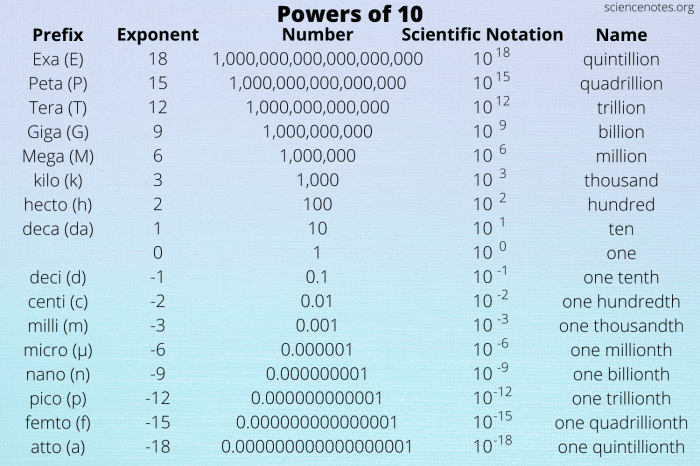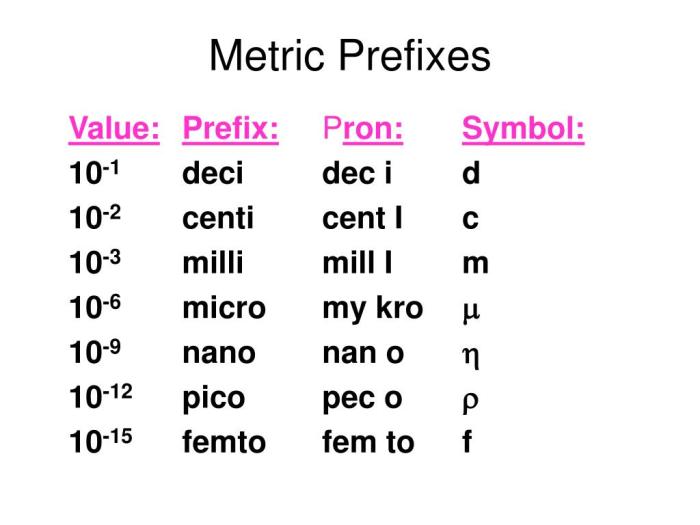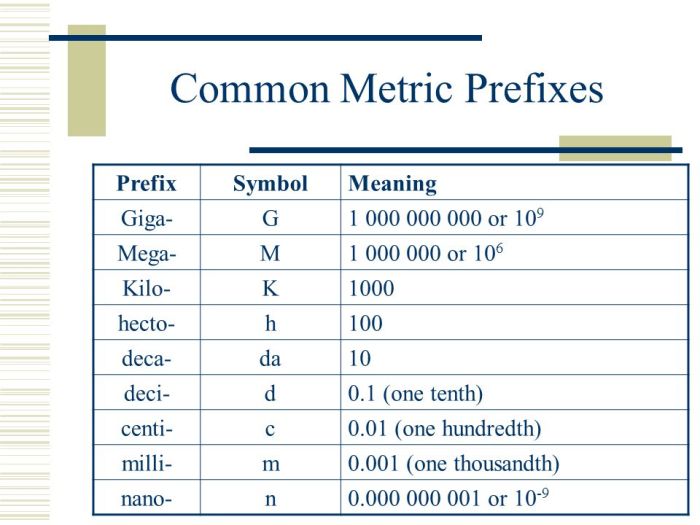Prefix with metric or biotic – In the realm of scientific terminology, prefixes hold immense significance, enabling us to quantify and describe the vastness of the natural world. Among these prefixes, two stand out: biotic, delving into the realm of life, and metric, spanning the spectrum of measurement.
Together, they form a powerful linguistic tool that enhances our understanding of the intricate workings of our universe.
Biotic prefixes, derived from the Greek word “bios” meaning life, adorn words that pertain to living organisms and their characteristics. Metric prefixes, on the other hand, stem from the Greek word “metron” meaning measure, and they modify units of measurement, allowing us to express values across a wide range.
Biotic Prefix

The biotic prefix originates from the Greek word “biotos,” meaning “life” or “living.” It is commonly used in scientific terminology to denote terms associated with living organisms, their characteristics, and their interactions with the environment.
The biotic prefix provides a concise and unambiguous way to identify concepts related to life sciences, distinguishing them from abiotic factors, which refer to non-living components of the environment.
Examples of Words Using the Biotic Prefix
- Biosphere:The part of the Earth that supports life, including the atmosphere, hydrosphere, and lithosphere.
- Biodiversity:The variety of life forms within a particular ecosystem or on the planet as a whole.
- Biotechnology:The application of biological principles and organisms to develop technologies and products.
- Biogeochemical cycle:The cycling of elements and compounds between living organisms and the environment.
- Biogeography:The study of the distribution of living organisms across the Earth.
Significance of the Biotic Prefix in Scientific Terminology
The biotic prefix plays a crucial role in scientific terminology by:
- Clarity and precision:It helps to avoid confusion by clearly indicating that a term refers to a living organism or a life-related concept.
- Categorization and classification:It allows scientists to categorize and classify organisms based on their shared characteristics and ecological roles.
- Interdisciplinary communication:The biotic prefix facilitates communication across different scientific disciplines that deal with living organisms, ensuring a common understanding of terms.
Metric Prefix: Prefix With Metric Or Biotic

Metric prefixes are symbols placed before a unit of measurement to indicate a multiple or fraction of that unit. They provide a convenient way to express very large or very small quantities in a concise and consistent manner.
The International System of Units (SI) defines a set of 20 metric prefixes, ranging from yocto (10 -24) to yotta (10 24). Each prefix represents a power of 10, allowing for easy conversion between different orders of magnitude.
Table of Metric Prefixes
The following table summarizes the different metric prefixes and their corresponding values:
| Prefix | Symbol | Value |
|---|---|---|
| Yotta | Y | 1024 |
| Zetta | Z | 1021 |
| Exa | E | 1018 |
| Peta | P | 1015 |
| Tera | T | 1012 |
| Giga | G | 109 |
| Mega | M | 106 |
| Kilo | k | 103 |
| Hecto | h | 102 |
| Deca | da | 101 |
| Deci | d | 10-1 |
| Centi | c | 10-2 |
| Milli | m | 10-3 |
| Micro | µ | 10-6 |
| Nano | n | 10-9 |
| Pico | p | 10-12 |
| Femto | f | 10-15 |
| Atto | a | 10-18 |
| Zepto | z | 10-21 |
| Yocto | y | 10-24 |
Use of Metric Prefixes in Scientific Notation
Metric prefixes are commonly used in scientific notation, a method of expressing very large or very small numbers in a more compact and readable format. Scientific notation involves writing a number in the form:
a × 10n
where “a” is a number between 1 and 10 (excluding 10) and “n” is an integer exponent representing the power of 10 by which “a” is multiplied.
For example, the number 602,214,129,000,000,000,000,000 can be written in scientific notation as:
02214129 × 1023
Using the metric prefix “exa” (E), this number can be further simplified to:
02214129 E23
This compact notation makes it easier to compare and manipulate large numbers in scientific calculations and discussions.
Comparison of Biotic and Metric Prefixes

Biotic and metric prefixes are both used to denote different orders of magnitude, but they differ in their specific applications and contexts.
Prefixes with metric or biotic origins often convey size or biological aspects. For instance, the prefix “micro-” in microbiology refers to tiny organisms. Similarly, in the essay “Let It Snow” by David Sedaris , the author employs the prefix “bio-” to describe the biological processes of a winter storm, such as the formation of ice crystals.
Similarities
- Both biotic and metric prefixes are used to represent different orders of magnitude.
- Both types of prefixes use a base-10 system, meaning that each prefix represents a power of 10.
- Both biotic and metric prefixes are used in a wide range of scientific and technical fields.
Differences, Prefix with metric or biotic
- Biotic prefixes are used to denote orders of magnitude in the context of biological systems, while metric prefixes are used to denote orders of magnitude in the context of physical systems.
- Biotic prefixes are typically used to represent very large or very small numbers, while metric prefixes are used to represent a wider range of numbers.
- Biotic prefixes are not as standardized as metric prefixes, and there is some variation in their usage across different fields of biology.
Appropriate Contexts
Biotic prefixes are most appropriate when discussing biological systems, such as the size of cells or the number of organisms in a population. Metric prefixes are most appropriate when discussing physical systems, such as the distance to a star or the mass of a planet.
Examples of Biotic and Metric Prefixes in Context

Biotic and metric prefixes play a crucial role in scientific communication, allowing scientists to convey large or small quantities and measurements with precision and clarity.
Biotic Prefixes in Taxonomy
Biotic prefixes are frequently used in taxonomy to describe the hierarchical levels of classification. For example:
- Kingdom: Animalia
- Phylum: Chordata
- Class: Mammalia
- Order: Primates
- Family: Hominidae
- Genus: Homo
- Species: Homo sapiens
Each prefix indicates a progressively narrower level of classification, with “kingdom” being the broadest and “species” being the most specific.
Metric Prefixes in Scientific Measurement
Metric prefixes are used to express quantities in multiples or fractions of the base unit. For example:
- Millimeter (mm): 1/1000 of a meter (used to measure small distances)
- Kilogram (kg): 1000 grams (used to measure mass)
- Megawatt (MW): 1 million watts (used to measure electrical power)
These prefixes enable scientists to express large or small values conveniently and consistently.
Importance of Correct Prefix Usage
Using prefixes correctly is essential in scientific communication for several reasons:
- Precision: Prefixes allow scientists to express quantities with the appropriate level of precision.
- Clarity: Prefixes prevent confusion and misinterpretation by ensuring that measurements are clearly understood.
- Standardization: The use of prefixes promotes standardization and consistency in scientific reporting.
Key Questions Answered
What is the difference between biotic and metric prefixes?
Biotic prefixes relate to living organisms, while metric prefixes modify units of measurement.
How are metric prefixes used in scientific notation?
Metric prefixes are used to express values in powers of 10, simplifying complex numbers.
In what contexts are biotic prefixes commonly used?
Biotic prefixes are frequently employed in biology, ecology, and other life sciences.
